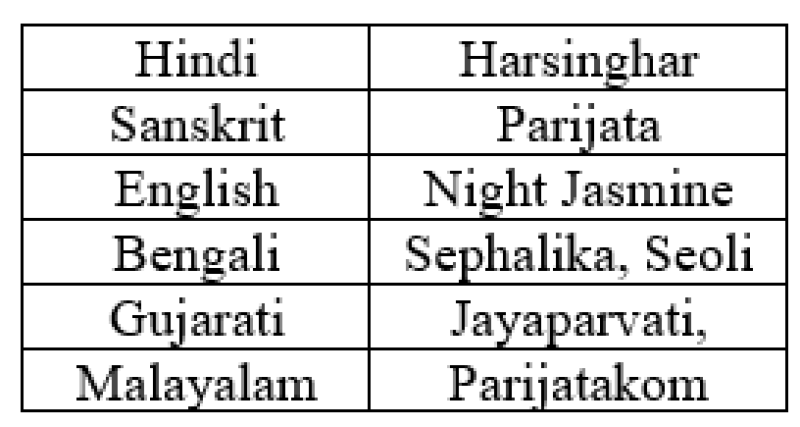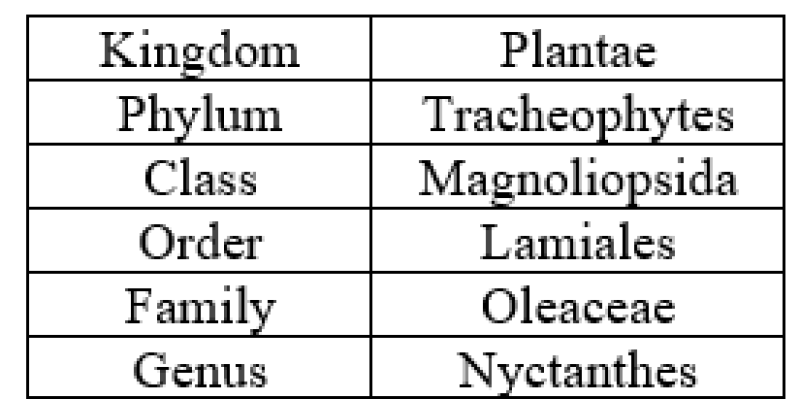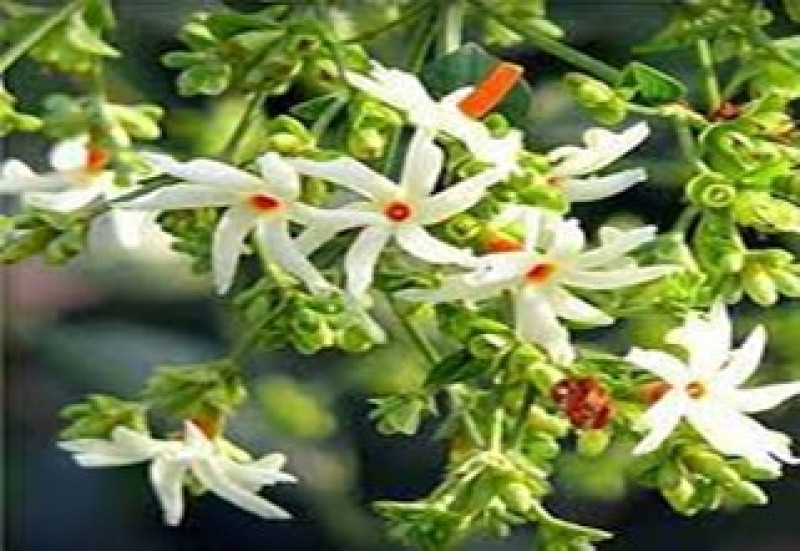Abstract
Since the ancient vedic period, green plants have been used for their medicinal properties to treat a wide range of illnesses. Nyctanthes arbortristis is a legendary plant of to the Oleaceae family, which has significant therapeutic properties in Ayurveda. Indian folklore claims that this plant is generally employed for religious purposes and is prized for its distinct scent and white orange flowers. Nyctanthes arbortristis is sometimes referred to as parijat or Harshringar. According to Hindu mythology, the Parijat tree sprang from the cosmic ocean that was churning during the Samudra Manthan. Legend has it that Lord Krishna brought the tree to Earth as a gift for his bride, Satyabhama. Today, people venerate the tree as a sacred symbol of fidelity and love. It is indigenous to Asia's southeast. Several phytochemical constituents such as, Flavanol glycosides, D-mannitol, ?-sitosterol, Astragaline, Nicotiflorin, Oleanolic acid, Nyctanthic acid, Ascorbic acid, Tannic acid, Phenolic compounds, tannins, cardiac glycosides, terpenoids, saponins, steroids, carbohydrates, proteins and alkaloids have been extracted from the plant. Now the pharmacological aspects, Leaves, bark, roots, and seeds are all crudely extracted and used in traditional medicine to cure a variety of ailments. Plant have analgesic, anti-inflammatory, anti-nociceptive, hepato-protective, antimicrobial, anti-fungal, anti-cancer, antidiabetic, anti-allergy, antioxidant, anticholinesterase, immunopotentiator, anti-filarial, anti-leshmanial, antiparasitic, CNS depressant, anti-anxiety, sedative, anti-anemic, anti-aggressive, antipyretic, ulcerogenic, anti-histaminic, anti-tryptaminergic, anti-malerial and immunostimulent activity. The goal of the current review is to gather current and thorough knowledge on Nyctanthes arbortristis, with a focus on its phytochemistry and range of pharmacological activities that have been scientifically proven.
Keywords
Fragrance, Anti-inflammatory, Depressant, Saponins, Nyctanthes, Flavanol
Introduction
The tiny, holy Nyctanthes arbor-tristis decorative tree is well-known throughout the nation for its lovely scent and white-orange blossoms. Ten meters tall, N. arbor-tristis has rough leaves, immature branches, stiff, white hair, and flaking grey bark. It is one of the most well-known and beneficial medicinal plants and a member of the Oleaceae family. Because of its powerful, pleasant aroma that lingers throughout the entire night, it is also known as Night Jasmine or Harsinghar. After midnight, the blossoms begin to fall, and by daybreak, the plant looks lifeless. The Greek terms "Nykhta" (night) and "anthos" (flower) are the sources of the generic name "Nyctanthes."The tree's gloomy appearance led to the particular name "arbortristis," which translates to "the sad tree” [1].
Geographical Distribution
Around the world, Nyctanthes arbor-tristis is extensively grown in tropical and subtropical climates. It originated in Southern Asia. It grows in the Terai tracts, Burma, Thailand, and Ceylon, as well as the Himalayan ranges from Chenab to Nepal, Bangladesh, the Indo-Pak subcontinent, and South-East Asia. It grows in the outer Himalayas of India and may be found in areas of Jammu and Kashmir, Nepal, Bengal, Tripura, and the eastern part of Assam, extending through the central region to the Godavari region in the south [2].
Type of soil and surroundings for plant growth
This tree thrives in a range of loamy soil types, particularly those with a pH of 5.6 to 7.5 that are typically found in gardens. The plant has to be kept in settings that range from full sun to moderate shade, and it requires regular watering but not excessive irrigation [3].
The plant has names in a variety of colloquial languages

Taxonomic description

MORPHOLOGICAL DESCRIPTION
Leaves
The opposite, simple, whole or serrated, petiolate, exstipulate leaves are 5–10 cm in length and 2.5–6.3 cm in width. They are oblong, acute or acuminate, and have a hairy, 6-cm-long petiole. While the upper surface is dark green with dotted glands, the below surface is light green and softly pubescent. N. arbor-tristis has a reticulate venation [4].
Flowers
The tiny, deliciously scented blooms are grouped at the terminal ends of branches or in the axils of leaves. They are frequently observed in clusters of two to seven [5].
Stem and Bark
This large shrub might grow up to ten meters in height. The N. arbor-tristis plant has brown or dark gray bark [6].
Seed
Each cell contains a single compressed seed. Exalbuminous seeds contain a high degree of vascularization, a thick testa, and an outer layer of large, transparent cells [7].
Fruits
The fruit has a single seed within each flat, brown, heart-shaped to spherical capsule that has a diameter of around 2 cm [8].
TRADITIONAL USES
The leaves, bark, roots, and seeds of Nyctanthes arbor-tristis are all crudely extracted and used in traditional medicine to cure a variety of ailments. The leaves have antibacterial, cholagogue, laxative, and diaphoretic properties. The N. arbor-tristis blossoms are used to induce menstruation. A sedative is made by infusing flowers in hot water. The flower promotes stomach secretions, enhances lung expectoration, and aids in the healing of mouth ulcers. Stem bark powder has historically been used to treat rheumatic joint discomfort. Seed powder is used to treat alopecia, scurvy on the scalp, skin conditions, and as an anthelmintic. Traditionally, roots have been utilized as an anthelminthic [9].
PHYTOCHEMICAL ASPECTS OF Nyctanthes arbortristis
N. arbor-tristis, contains phenolic compounds, tannins, cardiac glycosides, terpenoids, saponins, steroids, carbohydrates, proteins and alkaloids.
Phytochemical constituents from leaves
Benzoic acid, ?-Sitosterol, hentriacontane, ascorbic acid, friedelin, nicotiflorin, nyctanthic acid, ?Amyrin, mannitol, astringent, sugar, carotene, oleanolic acid, coloring materials, resinous substances, and traces of an oily substance, as well as astragalin, methyl salicylate, tannic acid, an amorphous resin, and traces of volatile oil are among the alkaloid nyctanthine [10].
Phytochemical constituents from flowers
?-digentiobioside ester of ?-crocetin (or crocin-1), ?-monogentiobioside ester of ?-crocetin (or crocin-3), d-mannitol, nyctanthin, essential oil, monoglucoside ester of ?-crocetin, glycosides, tannin, carotenoid, glucose, ?-monogentiobioside [11].
Phytochemical constituents from Seeds
Octadecenoic acid, glicerides of alpha-linoleic acid, lindogeneric acid, and stearic acid these are major chemical constituents which are isolated from seeds of N. arbor-tristis [12].
Phytochemical constituents from Stem
Stem contains sitosterol, 4-0-beta-glucopyranosyl-alpha-xylopyranoside, and glycosides naringenin [13].
Phytochemical constituents from Root
The root part of the plant composed of alkaloids, tannins and glucosides. ?-Sitosterol and Oleanolic acid these are major chemical constituents which are isolated from the roots of N. arbor-tristis [14].
Phytochemical constituents from bark
The bark contains alkaloids and glycosides [15].

Fig-1 Nyctanthes arbortristis (Harshringar)
STRUCTURE OF SOME PHYTOCHEMICAL CONSTITUENTS EXTRACTED FROM NYCTANTHES ARBORTRISTIS

PHARMACOLOGICAL ASPECTS OF Nyctanthes arbortristis
Antimicrobial activity
It has been discovered that tannins and phenolic compounds in the ethanolic leaf extract are effective against Salmonella typhi and Staphylococcus aureus [16].
Analgesic activity
By comparing the analgesic efficacy of the aqueous and ethanolic leaf extracts of N. arbor-tristis to the standard medicine aspirin, the percentage inhibition index revealed that the ethanolic extract exhibited superior analgesic effect [17].
Hepato-protective activity
It was discovered that N. arbor-tristis leaves and seeds exhibited anti-hepatotoxic action when it came to hepatotoxicity caused by carbon tetrachloride [18].
Antifungal activity
It has been discovered that the stem bark extracts (ethanol, chloroform, and petroleum ether) may have antifungal properties against Aspergillus niger and Candida albicans [19].
Anti-inflammatory activity
The aqueous extract of the whole plant and alcoholic extract of stem and leaves reported to have acute and subacute anti-inflammatory activity [20].
Anti-Cancer activity
The in vitro anticancer properties of N. arbor-tristis were evaluated using methanol extracts of its leaves, fruits, and stems. It is anticipated that the glycosides, tannins, phenols, and steroids found in the dried fruit methanol of N. arbor-tristis are the phytochemicals with the anticancer properties [21].
Anti-Malarial activity
Clinical investigation on 120 malaria patients. Ninety-two (76.7%) patients had their illness treated in just seven days after receiving a fresh paste made from five medium-sized N. arbortristis leaves, three times a day for seven to ten days. Eight patients did not react to therapy, while the other 20 patients were healed in 10 days [22].
Immunostimulent activity
An immunomodulator activity has been identified in N. arbor-tristis aqueous leaf extract [23].
Antianemic activity
Rats' hemoglobin content and red blood cell count increased dose-dependently when ethanolic extracts of the plant's flowers, barks, seeds, and leaves were used in a hematological study [24].
Anti-anxiety activity
Hydroalcoholic extracts of N. arbor-tristis have anxiolytic potential [25].
Antiallergic activity
Nyctanthes arbortristis has antiallergic compounds called arbortristosides A and C [26].
Anti-filarial activity
N. arbor-tristis plant have larvicidal activity against common filarial vector Culex quinquefasciatus [27].
CONCLUSION
According to a thorough review of the literature, N. arbor-tristis is a significant medicinal plant with a wide range of pharmacological uses. Numerous chemical compounds found in the plant are responsible for its diverse pharmacological and therapeutic properties. N. arbor-tristis has to be evaluated in order to formulate and employ the plant in actual therapeutic applications that may be used for the benefit of humankind.
REFERENCE
- Dewi, N. K. S. M., Fakhrudin, N., & Wahyuono, S. (2022). A comprehensive review on the phytoconstituents and biological activities of Nyctanthes arbor-tristis L. Journal of Applied Pharmaceutical Science, 12(8), 009-017.
- Barua, A., Junaid, M., Shamsuddin, T., Alam, M. S., Mouri, N. J., Akter, R., ... & Hosen, S. M. (2023). Nyctanthes arbor-tristis Linn.: A Review on its Traditional Uses, Phytochemistry, Pharmacological Activities, and Toxicity. Current Traditional Medicine, 9(1), 10-22.
- Sharma, L., Dhiman, M., Singh, A., & Sharma, M. M. (2021). Nyctanthes arbor-tristis L.:“An Unexplored Plant of Enormous Possibilities for Economic Revenue”. Proceedings of the National Academy of Sciences, India Section B: Biological Sciences, 91, 241-255.
- Agrawal, J., & Pal, A. (2013). Nyctanthes arbor-tristis Linn—A critical ethnopharmacological review. Journal of ethnopharmacology, 146(3), 645-658.
- Venkataraman, S., Harinya, S., Chidiuto, D. B., & Raja, R. R. (2019). Phytochemical Constituents and Pharmacological activities of Nyctanthes arbor-tristis. Research Journal of Pharmacy and Technology, 12(10), 4639-4643.
- Meshram, M. M., Rangari, S. B., Kshirsagar, S. B., Gajbhiye, S., Trivedi, M. R., & Sahane, R. S. (2012). Nyctanthes arbor-tristis a herbal panacea. International Journal of pharmaceutical sciences and research, 3(8), 2432.
- Santosh, J., & Manojkumar, P. (2016). A review on: Nyctanthes arbortristis Linn. Rejuvinating herbs. Int J Res Pharm Sci, 1(1), 54-62.
- Shrivastava, R., & Bharadwaj, A. K. (2018). Nyctanthes arbortristis an Important Medicinal Plant of Madhya Pradesh State-A Review. Pharmaceutical and Biosciences Journal, 10-15.
- Bhalakiya, H., & Modi, N. R. (2019). Traditional medicinal uses, phytochemical profile and pharmacological activities of Nyctanthes arbortris. RJLBPCS, 5, 1003-1023.
- Sharma, A., Goel, A., Gupta, N., & Sharma, B. (2023). Phytochemicals from Nyctanthes arbor-tristis and their biomedical implications. J. Med. Pharm. Allied Sci, 12, 6012-6020.
- Singh, A., & Vyas, B. (2018). Night Jasmine (Nyctanthes arbortristis). Research Journal of Pharmacognosy and Phytochemistry, 10(4), 324-330.
- Mishra, A. K., Tiwari, K. N., Saini, R., Chaurasia, J. K., & Mishra, S. K. (2023). Assessment of antioxidant potential in seed extracts of Nyctanthes arbor-tristis L. and phytochemical profiling by Gas Chromatography-Mass Spectrometry system. Brazilian Journal of Pharmaceutical Sciences, 58.
- Suresh, P. V., Shraddha, S. N., & Gopalkrishnan, B. (2013). Pharmacognostical studies of Nyctanthes arbor-tristis L. stem bark–A common but less known folklore herb. Int. Cl. 8: A01D 9/07, A01D 23/06, A01D 1/68, A01D 4/02, A01D 4/54, A61K 36/00, A01D 20/19, A01D 20/26, A01D 20/00.
- Samim, A., & Das, S. (2018). Preliminary phytochemical screening and to evaluate the anti-microbial activity of hydro-alcoholic and petroleum ether extract of jasmine root (nyctanthes arbour-tristis).(family-nyctaginaceae). International Journal of Current Pharmaceutical Research, 47-50.
- Talukder, S., Uddin, M. S., Ferdous, M., & Baral, P. K. (2022). Phytochemical Screening and Bioactivity Determination of Ethyl Acetate and Methanolic Extracts of Leaf and Bark of the Plant Nyctanthes arbortristis L. Eur J Med Health Sci, 2(6), 145-151.
- Vyas, A., & Sarin, R. (2013). Analysis of the phytochemical content and antimicrobial activity of Nyctanthes arbor-tristis. International Journal of Pharma and Bio Sciences, 4(1), 201-206.
- Debnath, S., Hazarika, A., & Sarma, J. Evaluation of Analgesic Activity of Ethanolic, Hydroethanolic, Aqueous and Chloroform Extracts of Nyctanthes arbortristis Leaves.
- Tripathi, V., Kujur, A., & Saluja, M. S. (2015). Hepatoprotective Activity of Stem Bark of Nyctanthes arbor-tristis linn. Research Journal of Pharmacology and Pharmacodynamics, 7(3), 124-128.
- Jamdagni, P., Khatri, P., & Rana, J. S. (2018). Green synthesis of zinc oxide nanoparticles using flower extract of Nyctanthes arbor-tristis and their antifungal activity. Journal of King Saud University-Science, 30(2), 168-175.
- Debnath, S., Hazarika, A., & Sarma, J. (2023). Anti-Inflammatory Activity of Ethanolic, Hydroethanolic, Aqueous and Chloroform Extracts of Nyctanthes Arbor-Tristis Leaves.
- Benefit, D. (2019). Anticancer activity of nyctanthes arbortristis. Int J Adv Res Ideas Innov Technol, 5, 84-87.
- Kumari, P., Sahal, D., Jain, S. K., & Chauhan, V. S. (2012). Bioactivity guided fractionation of leaves extract of Nyctanthes arbor tristis (Harshringar) against P falciparum. PLoS One, 7(12), e51714.
- Kumar, H., & Vasudeva, N. (2022). Immunomodulatory potential of Nyctanthes abrortristis stem bark. Journal of Ayurveda and Integrative Medicine, 13(2), 100556.
- Das, S., Sasmal, D., & Basu, S. P. (2014). Study on the effect of different parts of Nyctanthes arbortristis linn. on the hematological parameters of mice. Indian Journal of Research in Pharmacy and Biotechnology, 2(1), 965.
- Tripathi, S., Tripathi, P. K., Vijayakumar, M., Rao, C. V., & Singh, P. N. (2010). Anxiolytic activity of leaf extract of nyctanthes arbor-tristis in experimental rats. Pharmacologyonline, 2, 186-93.
- Nirmal, S. A., Pal, S. C., & Mandal, S. C. (2012). Mast cell stabilizing and bronchodilatory activity of Nyctanthes arbortristis bark. Phytopharmacology, 2(1), 234-242.
- Saini, P., Gayen, P., Kumar, D., Nayak, A., Mukherjee, N., Mukherjee, S., & Babu, S. P. S. (2014). Antifilarial effect of ursolic acid from Nyctanthes arbortristis: molecular and biochemical evidences. Parasitology international, 63(5), 717-728.


 Prabhu Dayal Rajan* 1
Prabhu Dayal Rajan* 1




 10.5281/zenodo.10886407
10.5281/zenodo.10886407